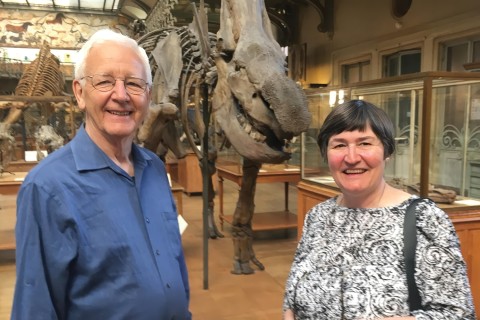February 7, Epiphany 5B (Mark 1:29-39)
Mark's Gospel provides tantalizing hints about Peter’s unnamed mother-in-law.
Mark wastes no time in his Gospel on niceties like the infancy narratives in Matthew and Luke or the highly nuanced hymn in John. Mark’s Jesus has been on the move with alacrity since verse 14 of this first chapter. This is no gradual or tentative inching into ministry but a leap into the fray. In Mark’s characteristic eagerness to get on with the Good News, he punctuates the onset of this ministry with an adverbial “and immediately” eight times in this chapter and twice in our little story alone. Jesus’ teaching with authority and his control over demons have led the locals to talk, and by verses 27–28, his fame as teacher and healer has begun to precede him.
I suspect that, given our experiences with COVID-19 over these last several months, we all have a lot more interest in health, as well as a longing to regain a kind of normalcy and a sense of community that simply cannot be satisfied by virtual gatherings. Our shared calling to serve others has been, if not halted entirely, hampered by restrictions on gathering.
Read our latest issue or browse back issues.
Jesus is renowned, in all of the Gospels, as a healer extraordinaire. When he cures someone from disease, he always restores them—not only to health, but also to hearth. So the several folk in this chapter and beyond, possessed by demons or spirits or otherwise indisposed, will return to their families and neighbors whole and sane, but they will also be enabled to pick up their lives and practice again as full members of their communities.
The Godly Play program for catechesis with children is famous for a series of wondering questions that follow the story of the week. Millennia earlier, the rabbis, our first serious interpreters of biblical texts, noted the importance of the white spaces between the words in the Bible for gaining insights about a given text. In the spirit of that program and of our ancient forebears in the faith, I wonder about Peter’s mother-in-law. We know nothing about her, not even her name, before this encounter with Jesus and that first tiny group of followers, and we know little of her life after her healing.
We are given a couple of clues about this extraordinary healing in the use of a few tantalizing Greek expressions: the first few describe Jesus’ actions, and the last gives us our first insight into Peter’s mother-in-law. Mark tells us that Jesus “raised her, holding her hand.” The fever left her “and she served them.” The heart of the story in one verse.
In many of the healing stories across the four canonical Gospels, Jesus mentions something about someone’s great faith, or about sins being forgiven, in the course of a healing. But this cure is the first that’s “just because,” a hint that something else might be afoot. The woman’s condition is described as “lying down” or even “laid aside” because of a fever; apparently she is unable to function normally and is therefore practically outside her community, including her own household.
Jesus’ first act, upon being told of her condition, is to go to her, touch her, and not simply heal her but “raise her up,” the same word used in descriptions of Jesus’ own resurrection. “Raising up” is not simply a description of a physical movement from prone to upright or even, as it is elsewhere in Mark, of healing. Her “raising up” is an implicit invitation.
Her response is variously translated: “she waited on them,” “cooked for them,” “served them.” It has been widely noted that the Greek term used for her action is the word from which we derive the word deacon, and this at the very beginning of this first Gospel.
In the world in which we live and move and have our being, service is a term for jobs of inferior rank: servers, the service industry, service stations. When we’ve become successful, says this ideology, others serve us. But the Jesus we meet in the Gospels, who “did not come to be served but to serve,” teaches us that service is the higher, even the highest calling (e.g., Mark 10:42–44). To serve for the sake of others is the mark of true discipleship.
Though the phrase “and immediately” does not appear in the description of the woman’s actions, it is clearly in the air. Before Mark talks about the ideal of radical service or even models it consistently, she serves—and does so, it seems, with the same vigor and alacrity that he demonstrated at the outset of his own ministry earlier in this chapter. And as is frustratingly true for the Gospels in general, the evangelist does not bother to tell us the rest of the story. Like others who have been touched by Jesus—like John’s woman at the well or Luke’s older brother of the prodigal or Matthew’s Magi—we don’t know anything about this woman’s further ministry, only this tantalizing hint about its outset.
Peter’s unnamed mother-in-law is an unlikely icon. Her story is really only recorded in a scant two verses, and like a lot of women in the Bible, we don’t even remember her name. What we do know is that, having been touched by Jesus, she is raised to the new, high calling of serving others, even before his so-called inner circle learns about it. She gets up, newly healed, and she serves. I would bet she doesn’t stop at verse 31.




